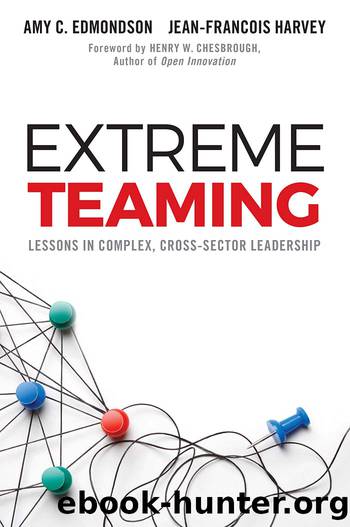Extreme Teaming by Edmondson Amy C.;Harvey Jean-François;Chesbrough Henry W.;

Author:Edmondson, Amy C.;Harvey, Jean-François;Chesbrough, Henry W.;
Language: eng
Format: epub
Publisher: Emerald Publishing Limited
Published: 2017-08-23T00:00:00+00:00
DIAGNOSING INTERFACES FOR KNOWLEDGE-SHARING
In addition to framing cross-boundary work as a resource to cultivate an environment in which people felt that their input was valued, we observed that project leaders focused on identifying and managing interfaces throughout their projects. Extreme teaming required transferring not only information, but also translating different interpretations and transforming individual interests to build shared meaning and understanding. We found that leaders would plan for specific moments during which intense cross-boundary work was needed, and strategically organized for these encounters. In some ways, they were curating a repertoire of knowledge-sharing needs and opportunities.
Just as in a relay race, exchanges of the baton between project participants were crucial to the outcomes in the projects we studied. The identification and orchestration of interfaces between project participants who did not know each other well and worked in different fields could easily make the difference as to whether development activities were transferred effectively from one group to another, or from one process stage to another. Recalled the director of the real estate company in Project Bianca: âWe gave ourselves a methodology on which the various professionals could rely to execute their project. [â¦] We knew when new input would be useful.â Added the director of the software company involved in the project: âIntermediation became more and more prominent for me. My main role during projects was to have good timing to jump in and provide intermediation between [the software company] and [the real estate company] professionals.â Project Sofiaâs leaders similarly assured a smooth transition through the different stages of development by instituting a formal process of knowledge translation.
With more complex products, multiple design streams may develop concurrently, requiring leaders to identify touch points between project participants to orchestrate their respective activities. Among the challenges faced during Project Willa were integrating and coordinating the projectâs many interfaces, which involved multiple stakeholders and oftentimes conflicting demands. Coordinating requirements for all stakeholders was a complex task that required a delicate balance. Project leaders introduced a strategy for âinterface managementâ that divided the final product into âvolumesâ based on physical and time boundaries set forth in a project volume register, each volume of which was âownedâ by a subproject team (empowering decision clusters, as illustrated with the next activity). An interface occurred when anything touched or crossed a boundary between volumes. High- and low-level interfaces were distinguished and captured in a register, and coordination meetings involving all relevant parties were regularly held. Orchestrating interfaces in such ways led to a more efficient and better-coordinated design process that promoted optimal use of materials and improved execution.
For key meetings, Project Annaâs leadership insisted on inviting certain professionals from the several involved organizations, and suggested, and sometimes even requested, that project participants work in locations in which they would directly interact with one another. Similarly, âthe project as we know it today,â explained a director from the architecture company working on Project Willa, âis the result of architects and engineers working side by side at key times in the project.
Download
This site does not store any files on its server. We only index and link to content provided by other sites. Please contact the content providers to delete copyright contents if any and email us, we'll remove relevant links or contents immediately.
Hit Refresh by Satya Nadella(9040)
The Compound Effect by Darren Hardy(8813)
Change Your Questions, Change Your Life by Marilee Adams(7637)
Nudge - Improving Decisions about Health, Wealth, and Happiness by Thaler Sunstein(7620)
The Black Swan by Nassim Nicholas Taleb(7014)
Deep Work by Cal Newport(6884)
Daring Greatly by Brene Brown(6449)
Rich Dad Poor Dad by Robert T. Kiyosaki(6412)
Principles: Life and Work by Ray Dalio(6220)
Playing to Win_ How Strategy Really Works by A.G. Lafley & Roger L. Martin(5928)
Man-made Catastrophes and Risk Information Concealment by Dmitry Chernov & Didier Sornette(5923)
Digital Minimalism by Cal Newport;(5665)
Big Magic: Creative Living Beyond Fear by Elizabeth Gilbert(5615)
The Myth of the Strong Leader by Archie Brown(5427)
The Slight Edge by Jeff Olson(5351)
Discipline Equals Freedom by Jocko Willink(5286)
The Motivation Myth by Jeff Haden(5157)
Stone's Rules by Roger Stone(5027)
The Laws of Human Nature by Robert Greene(5001)
